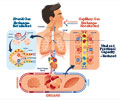Zero gravity: Reduced gravity or gravitational unloading may cause deterioration of motor control in astronaut. Here’s how can astronauts avoid these neuromuscular problems?

‘Reduced gravity is more likely to affect astronaut’s muscles and nerve responses. So, while exercising, astronauts should walk or slowly run with rear foot-strike landing (using a bungee cord would help too). Periodic passive stretching of the soleus also seems to be effective.’
Read More..




But, what happens to these muscles when there is no gravity (or an “unloading” of gravitational force) for them to work against? The question might sound ridiculous to some, but not to an astronaut aboard the International Space Station (ISS)! In outer space, where gravity is minimal, our muscles (especially the anti-gravitational ones) are not used as much, which might result in their atrophy and changes to their structure and properties. In fact, human calf muscles are known to reduce in volume during a flight in space. Read More..
How can Astronauts Avoid These Neuromuscular Problems?
A team of researchers from Japan led by Dr. Yoshinobu Ohira of Doshisha University, Japan set out to seek the answer. The team also included Dr. Takashi Ohira, who works with Doshisha University and Kindai University, Japan; Dr. Fuminori Kawano, associated with Doshisha University and Matsumoto University, Japan; Dr. Katsumasa Goto, who is with Doshisha University and Toyohashi SOZO University, Japan; and Dr. Hiroshi Kaji from Kindai University. They were recently able to study the responses of neuromuscular properties to gravitational unloading, and share research-based insights into how astronauts can avoid neuromuscular problems during an extended spaceflight. This review—which was made available online on March 10, 2022 and published in Volume 136 of Neuroscience & Biobehavioral Reviews in May 2022—was written in response to an invitation asking the authors to contribute to a special issue. This issue, titled ‘Space Neurosciences’, was meant to commemorate the first human landing on the Moon, as part of NASA’s Apollo 11 lunar mission.The team reviewed how the morphological, functional, and metabolic properties of the neuromuscular system respond to lowered anti-gravitational activities. They looked at human and rodent simulation models first and also saw how afferent and efferent motoneuron activity regulated neuromuscular properties. Their review suggests that afferent neural activity (which involves the signals sent from skeletal muscle to the central nervous system during muscular activity) plays a key role in regulating muscle properties and brain activity.
Inhibiting anti-gravitational muscle activities results in remodeling of the sarcomeres (which are the structural unit of muscles), resulting in a decrease in their number, further causing a decrease in force development eventually leading to muscular atrophy. A reduction in the amplitude of the electromyograms in anti-gravitational muscles, namely the Soleus and the Adductor Longus, is also seen. This indicates that exposure to low-gravity environments affects not only the muscles, but also the nerves.
Gravitational unloading causes deterioration of motor control, seen as impaired coordination of antagonist muscles and altered mechanics. Walking difficulty was also observed in crews after spaceflight, although they exercised regularly on the ISS. Astronauts aboard the ISS are required to use treadmills, bicycle ergometers, and resistance training equipment to counter the effect of reduced gravity on the neuromuscular system and safeguard their physical health. However, these exercise-based countermeasures are not always effective in preventing certain unwanted neuromuscular changes.
Advertisement
Changes in muscular properties due to gravitational unloading may be related to a decrease in neural activity, as well as contraction- and/or stretch-dependent mechanical stress. Stimulating the Soleus muscle adequately seems to reduce chances of its atrophy. So, while exercising, astronauts should walk or slowly run with rear foot-strike landing (using a bungee cord would help too). Periodic passive stretching of the Soleus also seems to be effective.
Advertisement
Source-Eurekalert










